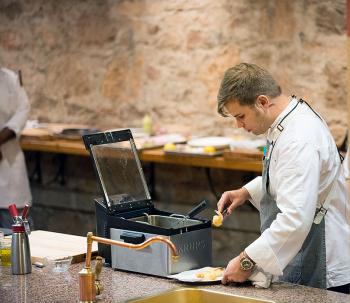
Chef Cory Bahr
--Kristen Loken photo
Louisiana’s Cory Bahr takes stage at Culinary Institute of America’s
Cory Bahr’s day job is chef, but he moonlights as a missionary for Louisiana Seafood. In early March he had the opportunity to spread the gospel at the Greystone Flavor Summit, a think tank for high-volume food and beverage professionals, held on the Culinary Institute of America’s campus in St. Helena, California.
The theme of this year’s summit was “Looking in our Own Backyard: A Focus on America.” And nowhere is there a backyard more bountiful than the shores of Louisiana. “Out our back door is the Gulf of Mexico,” Bahr said, enumerating some of the less familiar species found there: snapper, black drum, amberjack, sheepshead and grouper.
Most chefs and their customers are familiar with the flavor and quality of Gulf shrimp and oysters. But Bahr, the 2011 King of Louisiana Seafood, feels called to educate others about the lesser-known species and their potentials for creative and revenue-generating menu items. “It’s a great value that chefs can pass on to their guests.”
“People don’t know how to use alligators and turtles. In Louisiana, if we have a problem, we eat it,” he said. (For the record, alligator counts as seafood for Friday Lenten observance.)
To illustrate his point, Bahr conducted a demonstration at the Summit where he pan-roasted Louisiana snapper and paired it with crawfish and peaches pickled with crushed lemon leaves he picked that morning straight from Napa Valley. Not to overlook the crowd-pleasers, he also prepared an Oyster Carbonara, crispy Louisiana shrimp with pepper jelly and an herb salad.
Throughout the Summit, sustainability and storytelling recurred.
“We’ve been fishing in Louisiana for 10 or 12 generations. How irresponsible would it be not to treat Gulf waters in a sustainable fashion?” Bahr asked, noting that traceability is also important. “Every receipt I get says where [the product] comes from.”
And Louisiana never lacks for a good story. “When the Cajuns were run out of Nova Scotia, the lobster followed them all the way to Louisiana,” Bahr joked. “But it didn’t eat on the long journey and became very, very thin and turned into a crawfish. And that’s a true story.”
Bahr shared the podium with Sal Sunseri, owner of New Orleans-based P&J Oyster Company, which has been harvesting and distributing oysters for more than 130 years. Sunseri, who is also chairman of Louisiana Seafood Promotion and Marketing Board, spoke about the highly regulated oyster industry, his concerns about sustainability and, of course, his state’s love for celebrating food. “We have a festival every week, and we have an oyster festival every year,” Sunseri said. The 2015 New Orleans Oyster Festival is May 30 and 31.
After his presentation, Bahr shared his thoughts on the experience. He praised the CIA for its “amazing dedication to the craft. We’re lucky to have a facility like this to educate our future stars. Coming here is like going to the hall of fame. It’s inspiring to represent my state here.”
Bahr learned the business the old-fashioned way—starting in kitchens at 16. “I didn’t even know culinary school was an option. I didn’t even finish high school.”
Nevertheless, at 39, he’s the chef/owner of two successful restaurants in his hometown of Monroe — Cotton and Nonna. And he’s won his share of awards — the 2014 People’s Best New Chef for the Gulf Coast Region by Food & Wine magazine and a 2012 Food Network Chopped championship. His recipes are also featured in influential culinary magazines such as Louisiana Cookin’ and Food Arts.
At the Summit, he was on a national stage presenting to the leaders of food and beverage for global hotel groups, casinos and cruise lines such as Marriott, Disney, Intercontinental and Princess Cruises.
“It’s humbling to possibly influence people to buy more Louisiana Seafood,” Bahr said. “We’re creating a memory with a product that hopefully they will work into their budgets.”
And like all chefs who visit Napa Valley, he made pilgrimages to certain iconic restaurants such as The Restaurant at Meadowood. “It’s part of my education,” he said.
Inspiring, generating and sharing ideas and making connections — that’s what the Summit is all about.
- Log in to post comments
